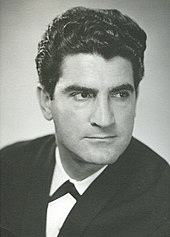Iranian jazz
| Music of Iran | ||||
| General topics | ||||
|---|---|---|---|---|
| Genres | ||||
| Specific forms | ||||
|
||||
| Media and performance | ||||
|
||||
| Nationalistic and patriotic songs | ||||
|
||||
Iranian jazz refers to jazz music composed by Iranian musicians, sometimes combined with traditional Iranian elements.
History
[edit]Early years
[edit]
Jazz music emerged in Iran along with the development of western influences into the pop music. One of the pioneers of jazz music in Iran was Alfred Lazaryan, a little-known singer and dancer whose first recorded song made a hit on the Iranian national radio.[4] However, Lazaryan soon gave up singing.[4] Viguen Derderian, a celebrated pop and jazz artist popularly known simply as "Viguen", began his career in the early 1950s.[3] Viguen's first song, Moonlight, which was released in 1954,[1] was also an instant hit on the radio,[3] and is considered to have marked a turning point in Iran's western-influenced music.[1] Viguen created some of Iran's most memorable songs, including collaborations with Delkash,[3] and was known as Iran's "Sultan of Jazz".[1][2][3][5]
After the 1979 Revolution
[edit]A music group named Ejazz performed the first officially sanctioned jazz music concert in post-revolutionary Iran.[6] They produced jazz fusion, incorporating elements from the indigenous classical music.[6]
Rana Farhan, an Iranian jazz and blues singer living in New York,[7] combines classical Persian poetry with modern jazz and blues.[8] She has established a model to the jazz fusion project that she continues to incorporate in her work. Her best-known work, Drunk With Love, is based on a poem by prominent 13th-century Persian poet Rumi.[7]
Bomrani, one of the first country blues bands in post-revolutionary Iran, was founded in 2008, as part of a new wave of influences onto the music stages of Tehran.[9] Pallett, a similarly successful band that was formed in 2009,[10] composes jazz fusion of clarinet, cello, and double bass.[9] They have garnered a huge following in Iran, and have also performed abroad.[11]
Samples
[edit]See also
[edit]References
[edit]- ^ a b c d Armbrust, Walter (2000). Mass Mediations: New Approaches to Popular Culture in the Middle East and Beyond. University of California Press. p. 70. ISBN 9780520219267.
- ^ a b Saba, Sadeq (October 27, 2003). "Iranian pop legend dies at 74". BBC News. BBC News. Retrieved August 18, 2014.
- ^ a b c d e Saba, Sadeq (November 26, 2003). "Obituary: Vigen Derderian". The Guardian. London. Retrieved March 24, 2013.
- ^ a b "گفتگوئی با آلفرد لازاریان" [An Interview with Alfred Lazaryan]. Sepid-o-Siah magazine (in Persian) (956 ed.). Tehran, Iran. February 9, 1972.
- ^ Zinder, Jac (March 19, 1992). "The King of Persian Pop: Never a Dull Nouruz". Los Angeles Times.
- ^ a b "اولین کنسرت جز ایرانیزه شده با سبک تلفیقی بعد از انقلاب در ایران" [The First Iranized Jazz Concert with a Fusion Style After the Revolution in Iran]. Musicema (in Persian). November 8, 2010.
- ^ a b Curiel, Jonathan (September 24, 2013). "Rana Farhan Sings the 'Persian Blues'". KQED Arts. Retrieved March 7, 2015.
- ^ Smith, Emily Esfahani (August 30, 2011). "Persian Poetry Gets the Blues". The Wall Street Journal. Retrieved April 5, 2018.
- ^ a b "Iranian blues and jazz bands find fans in Tehran". Reuters. November 13, 2014.
- ^ "Pallett Releases 'Endless Ending'". Financial Tribune. March 1, 2017.
- ^ "Iranians love their klezmer". Public Radio International. February 26, 2016.

